Physical Address
304 North Cardinal St.
Dorchester Center, MA 02124
The anal canal forms during the fourth to seventh weeks of gestation after partitioning of the cloaca into the ventral urogenital membrane and dorsal membrane. The epithelium of the superior two-thirds of the primitive anal canal is derived from the endodermal hindgut; the inferior one-third develops from the ectodermal proctodeum. The dentate line, also known as the pectinate line, is located at the inferior limit of the anal valves and delineates where these two epithelial derivatives fuse. The dentate line also indicates the approximate former site of the anal membrane that ruptures in the eighth week of gestation. The outer layers of the wall of the anal canal are derived from the surrounding splanchnic mesenchyme.
The anal canal is defined surgically by the borders of the internal anal sphincter ( Fig. 32.1 ) and varies from 3 to 4 cm in length. , The surgical anal canal begins at the apex of the anal sphincter complex. This is a palpable landmark (anal rectal ring) and is located approximately 1 to 2 cm proximal to the dentate line. It ends where the nonkeratinizing squamous mucosa terminates at the perianal skin. The internal sphincter is the most distal portion of the internal circular layer of the muscularis propria and is continuous with the muscularis propria of the colorectum. The surface of the anal canal is lined by vertical mucosal folds termed anal columns (columns of Morgagni) and is separated by anal sinuses (sinuses of Morgagni). The columns connect at the most distal end by a horizontal row of mucosal folds known as the anal valves . Anal valves are typically most evident in children, but they may become more prominent with advancing age.
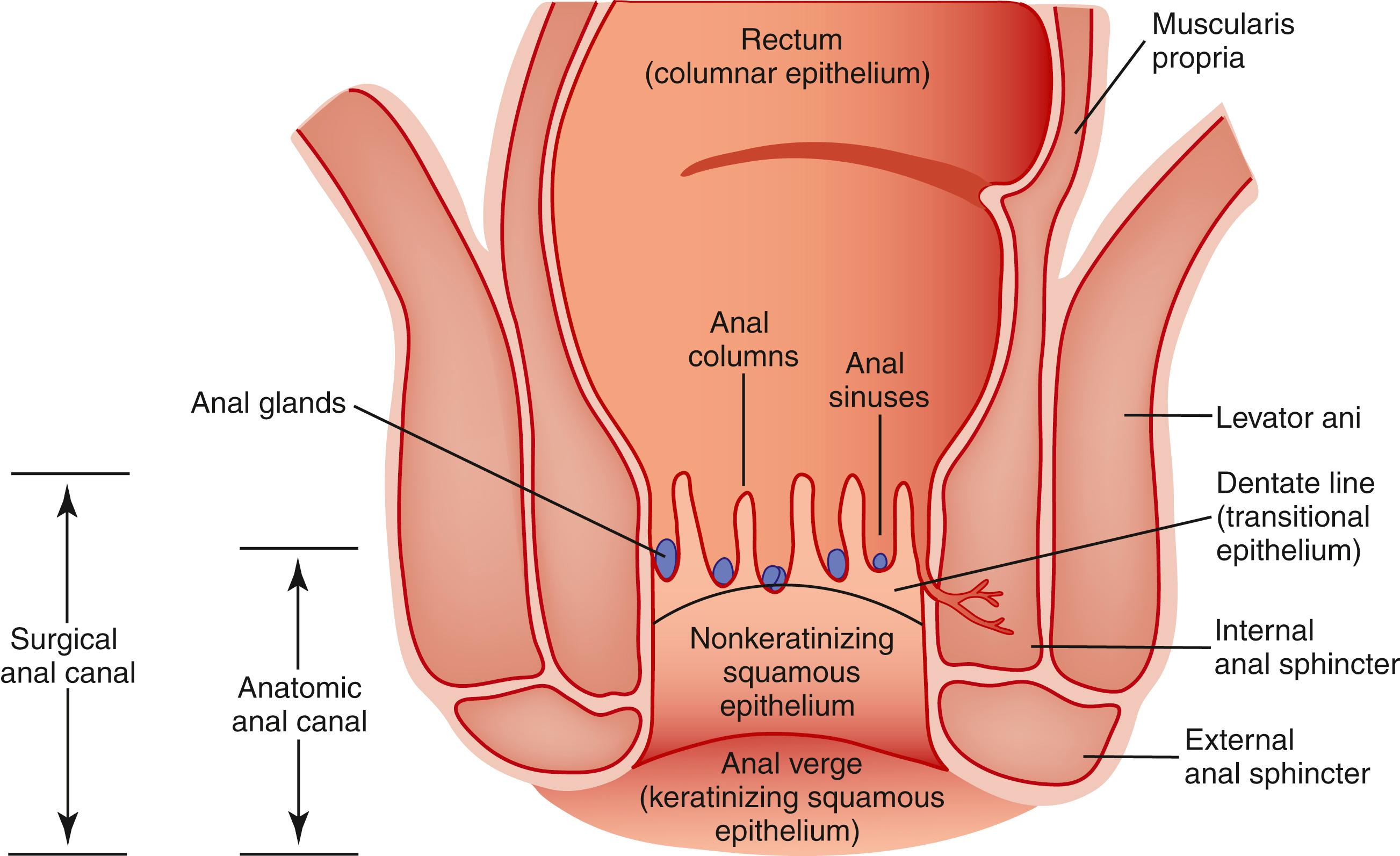
The location of the anal valves corresponds to the dentate line, which is located approximately at the midpoint of the surgically defined anal canal. The dentate line corresponds, generally, to the squamocolumnar junction. This is not an abrupt transition, but an actual transition zone that extends from several millimeters to just over 1 cm in length. Microscopically, the epithelium lining the anal transition zone varies from a type that resembles the lower genitourinary tract to stratified squamous, columnar, or cuboidal, with islands of colorectal-type epithelium also frequently present ( Fig. 32.2 ). Despite its resemblance to bladder epithelium, the anal transition zone expresses cytokeratins (CKs) CK7 and CK19, but not CK20. , Immunohistochemical studies for HMB45 and S100 protein have also demonstrated the presence of melanocytes in the anal transitional epithelium, although these are usually more prominent in the anal squamous zone. Microscopically, the mucosal lining superior to the transition zone is columnar, whereas the mucosa inferior to the transition zone is stratified squamous. The squamous mucous membrane is devoid of hair and other cutaneous appendages and does not keratinize. The anal canal ends at the anal verge, where the anal squamous mucosa merges with the true anal skin and one can detect hair follicles, sweat glands, and apocrine glands.
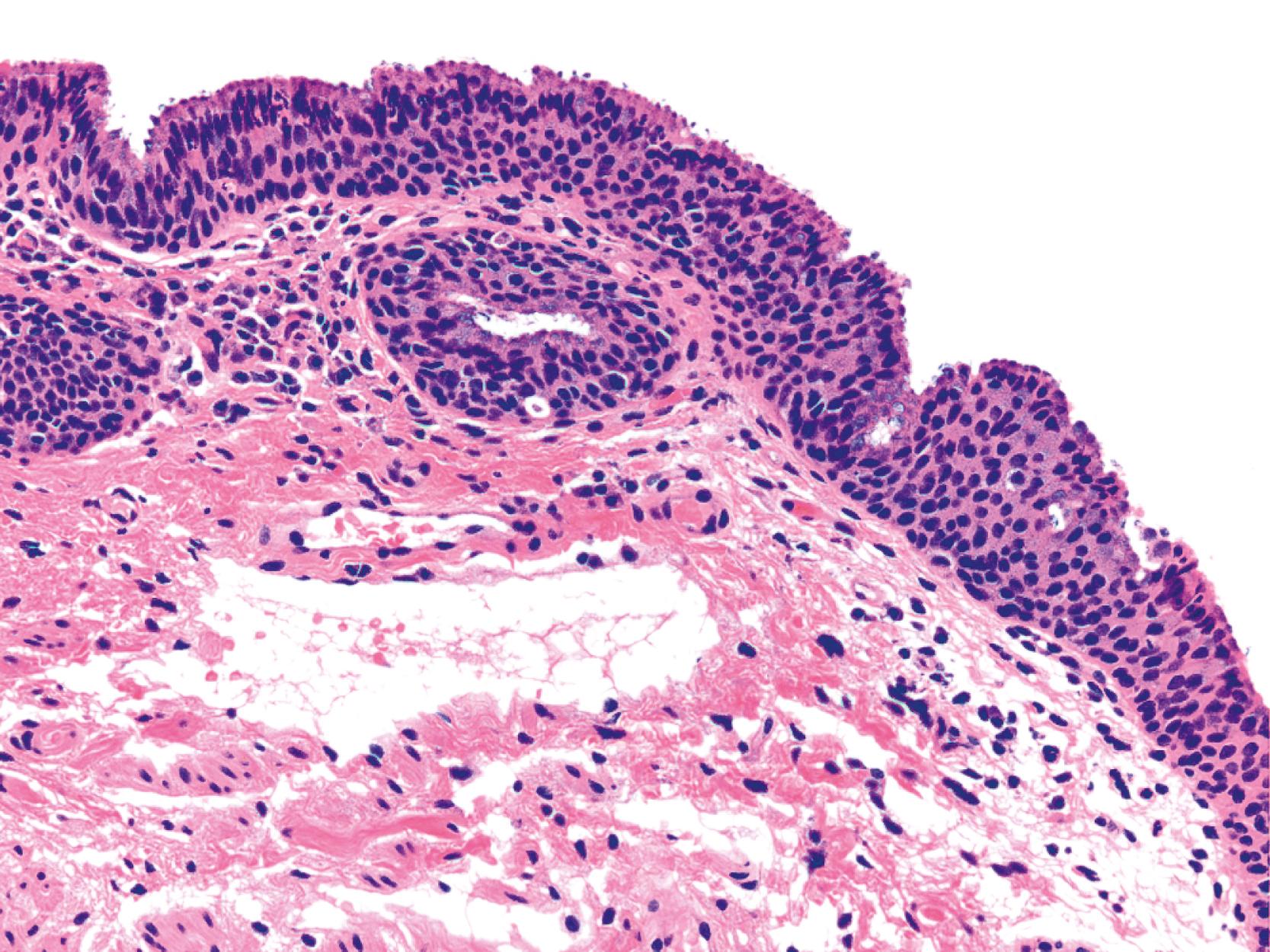
The anal ducts are long, tubular structures that closely approach or penetrate the internal sphincter muscle and may even undermine the rectal mucosa. These ducts are lined by transitional epithelium and mucus-producing cells, which are most common at the terminal portion of the ducts before their opening into the anal crypts. Nodules of lymphoid tissue are often seen surrounding these ducts. The epithelium lining the ducts shows a similar immunohistochemical profile to that of the overlying transitional mucosa (CK7+ and CK20–). ,
The dual embryological origin of the anal canal results in a dual blood supply, venous and lymphatic drainage, and nerve supply. The superior two-thirds of the anal canal is supplied by the superior rectal artery, a continuation of the inferior mesenteric artery; the venous drainage of the superior anal canal flows into the superior rectal veins, tributaries of the inferior mesenteric vein. The lymphatic drainage of the superior two-thirds of the anal canal is to the inferior mesenteric lymph nodes. In contrast, the inferior third of the anal canal is supplied primarily by the inferior rectal arteries, which are branches of the internal pudendal arteries. The venous drainage of this portion of the anal canal is to the inferior rectal veins, which are tributaries of the internal pudendal veins and, ultimately, the internal iliac veins. Lymphatic drainage is to the superficial inguinal lymph nodes. The nerve supply of the superior two-thirds of the anal canal is through the autonomic nervous system; the inferior third is supplied by the inferior rectal nerve through the sacral plexus.
These aforementioned differences in embryology, blood supply, drainage, and nervous innervation are clinically relevant, particularly when evaluating congenital malformations of the anal canal and predicting patterns of spread of neoplasms. In surgical pathology practice, it may be difficult to determine whether a tumor has arisen within the distal rectum, the anal canal, or the anal margin/perianal skin because these anatomical zones overlap. Furthermore, bulky tumors often obliterate the normal anatomy. The eighth edition of the American Joint Committee on Cancer Staging Manual states that adenocarcinoma proximal to the dentate line/anorectal ring should be staged as rectal cancers and squamous cell carcinomas distal to the dentate line/anorectal ring should be staged as anal canal cancers. Identification of skin appendages helps delineate perianal skin carcinomas from true anal canal cancers. Perianal cancers are also defined by the presence of a tumor that is located within a 5-cm radius of the anus and is completely visualized after gentle traction is placed on the buttocks. An anal canal tumor should not be completely visualized after gentle traction. Perianal cancers are staged as anus/anal canal carcinomas.
Anorectal malformations occur in approximately 1 in 5000 live births , and affect males slightly more commonly than females. They range from minor anal anomalies to complex cloacal malformations. The most common congenital anomaly of the anus is anal atresia, which accounts for up to 75% of all anorectal malformations. Anorectal agenesis accounts for approximately 10% of all anal atresias. Up to two-thirds of congenital anal anomalies occur in association with anomalies in other organ systems, most often the genitourinary system, but also the central nervous system, skeleton, cardiovascular system, and gastrointestinal tract. Patients usually present early after birth with failure to pass meconium or with meconium that extrudes from a fistulous opening.
The cause of anorectal malformations is multifactorial. Given that about 5% to 10% of malformations arise in children with a chromosomal abnormality, most commonly trisomy 21, and that a number of monogenetic syndromes reveal anorectal malformations as one of their features, genetics are considered an important component of their pathogenesis. Furthermore, anorectal malformations are more common in siblings of patients with anorectal malformations. Ninety-five percent of patients with trisomy 21 and anorectal malformations have an imperforate anus without a fistula, compared with only 5% of all patients with anorectal malformations. Lastly, an association with congenital abnormalities, including anorectal malformations, has been found in infants conceived by assisted reproduction methods.
Anorectal malformations are recognized by their gross (anatomical) features. The “Wingspread” classification of anorectal malformation is subdivided into high, intermediate, and low atresia based on the level of termination of the anorectum in relation to the levator ani muscle. , This classification does not help guide surgery or help predict outcome, however. Fistula formation is a common finding in anorectal malformations, particularly in high and intermediate forms of anal atresia, and it may be rectovesical, rectoprostatic, rectourethral (most common type in males), or anocutaneous in males and rectovaginal, rectovestibular (most common type in females), or anoperineal in females. More recently, the classification of anorectal malformations has been revised into the Krickenbeck scheme ( Box 32.1 ), which adds emphasis on the type of fistula associated with the malformation. The type of fistula helps determine the location of the blind pouch and also helps guide the surgeon’s expectations regarding the length of the atretic segment to be resected at the surgical pull-through procedure. In patients with a cloacal disorder, a single perineal orifice is found where the urinary tract, vagina, and rectum all converge into a common channel.
A posterior sagittal approach is considered the gold standard for defining and repairing anorectal anomalies. This approach has greatly improved outcomes in anorectal malformation repair over the past several decades. , The level of anal atresia (high, intermediate, or low) in relationship to the levator ani muscle is directly related to functional prognosis and rates of fecal continence or constipation following a surgical pull-through procedure. Anorectal agenesis has a poor prognosis for fecal continence because affected patients lack a functional puborectalis sling mechanism as well as internal and external anal sphincters. The prognosis for anal atresia located inferior to the levator ani muscle depends on the presence of functional sphincters as well as intact sensation; atresias isolated to the anus, such as imperforate anal membrane, carry the most favorable surgical prognosis. In patients with cloacal disorders, prognostic factors include the quality of the sacrum, the quality of the muscles, and the length of the common channel. Surgical repair for patients with a common channel less than 3 cm in length is feasible for most pediatric surgeons, whereas surgical repair for patients with a common channel greater than 3 cm in length should be performed at a specialized center by an experienced surgeon. In the first 24 to 48 hours after birth of an infant with an anorectal malformation, the major issues relate to identification of life-threatening anomalies and whether to repair the defect immediately or to perform a protective colostomy with repair at a later date. These decisions are based on the infant’s physical examination, the extent of the malformation, and any significant changes that occur in the first 24 hours of life. Once this critical period passes and the features of the infant’s malformation are recognized, the surgeon can proceed to repair the defect.
About one-third of patients undergoing screening colonoscopy are found to have hemorrhoids, but precise prevalence data are not available. Men and women are likely equally affected, and the peak age at diagnosis is between 45 and 65 years of age. Whites are affected more often than African Americans. Painless bleeding is the most common sign of hemorrhoids; pain may occur if the hemorrhoids become thrombosed or strangulated. Hemorrhoids rarely lead to anemia; thus, if a patient presents with anemia, other potential causes should be investigated. With age, the hemorrhoidal tissue may gradually engorge and extend further up into the anal canal, where it becomes susceptible to the effects of straining at defecation. Internal hemorrhoids usually become symptomatic only when they prolapse, become ulcerated, bleed, or thrombose. External hemorrhoids may be asymptomatic or associated with discomfort, acute pain, or bleeding from thrombosis or ulceration.
Current evidence indicates that hemorrhoids actually represent cushions of fibrovascular and connective tissue normally present in the anal submucosa and consist of direct arteriovenous communications, mainly between the terminal branches of the superior rectal and superior hemorrhoidal arteries. These cushions serve a protective role during defecation and help maintain continence. , , Hemorrhoidal tissues are thought to arise from abnormal dilation of the internal hemorrhoid venous plexus, distention of the arteriovenous anastomoses, prolapse of these cushions, or elevations of anal sphincter pressure with resultant vascular congestion; however, this theory has not been rigorously tested. Thus any cause of elevated intraabdominal pressure, such as straining at defection, inadequate fiber intake, prolonged lavatory sitting, constipation, diarrhea, and conditions such as pregnancy, ascites, and pelvic space-occupying lesions, have all been implicated in hemorrhoid development, but not necessarily proven. , Portal hypertension, in itself, is not associated with hemorrhoid formation. Rather, hemorrhoidal bleeding in the presence of portal hypertension may be related to the presence of a coagulopathic disorder, rather than simply venous engorgement.
Hemorrhoidal tissue is located on the left lateral, right anterior, and right posterior aspects of the anal canal. Internal hemorrhoids are classified according to their site of origin; the dentate line serves as an anatomic/histological border for classification and grading. External hemorrhoids originate distal to the dentate line, arising from the inferior hemorrhoidal plexus, and are lined by modified squamous epithelium. Internal hemorrhoids originate proximal to the dentate line, arising from the superior hemorrhoidal plexus, and are covered with rectal or transitional mucosa. Microscopically, excised specimens show evidence of dilated thick-walled submucosal vessels and sinusoidal spaces, often with thrombosis and hemorrhage into the surrounding connective tissues ( Fig. 32.3 ). Internal hemorrhoids are graded from I to IV based on degree of prolapse and their ability to be reduced ( Table 32.1 ).
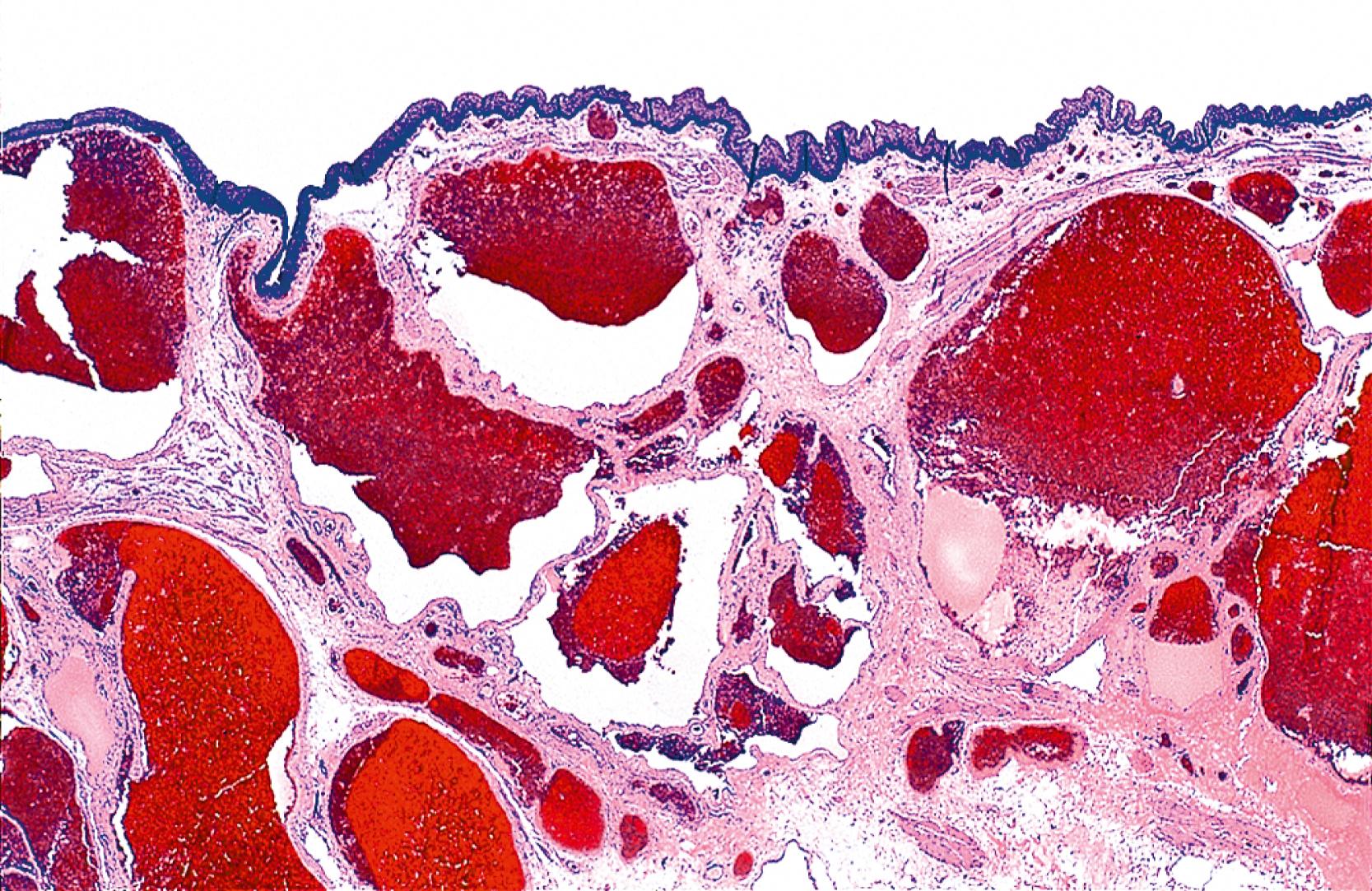
| Grade | Clinical Feature |
|---|---|
| I | No prolapse during Valsalva maneuver |
| II | Prolapse during Valsalva maneuver, but spontaneously reduce |
| III | Prolapse during Valsalva maneuver and need manual reduction |
| IV | Cannot be reduced |
All tissues excised as clinical hemorrhoids should be examined histologically because the differential diagnosis of an anal mass and anal bleeding includes entities such as colorectal or anal carcinoma, anal melanoma, inflammatory bowel disease, and infection. Furthermore, hemorrhoidectomy may be complicated by subsequent anal incontinence. While anal sphincter injury secondary to hemorrhoidectomy is typically assessed via endoscopic ultrasonography, documenting the histological presence or absence and quantity of smooth muscle and skeletal muscle bundles may be helpful to guide physicians as to the potential cause of the patient’s incontinence. Anal fibroepithelial polyps, discussed in the next section, are often confused clinically with hemorrhoids because of their similar gross appearance.
Nonoperative measures, such as Sitz baths, analgesics, topical anesthetics, increased dietary fiber, and stool softeners, can be offered to patients with mild symptoms or minimally symptomatic hemorrhoids. If these methods fail, sclerotherapy, rubber band ligation, cryotherapy, or surgical therapy should be considered. Surgical treatment should be individually tailored to each patient according to the degree of symptoms, coexisting anorectal diseases, and the degree of external anorectal component. Complications of hemorrhoidal disease are mostly related to treatment. Mild complications include pain, urinary retention, and constipation. Severe complications include fistula formation, rectal prolapse, and incontinence.
Hypertrophied anal papillae, also known as anal fibroepithelial polyps, are benign polypoid projections of anal squamous epithelium and subepithelial connective tissue. They result from enlargement of anal papillae, which are barely perceptible triangular protrusions located at the base of the anal columns (columns of Morgagni). They are present in 45% of patients who undergo proctoscopic examination and are believed to be acquired structures. They are twice as common in men as in women, and they range in size from 0.3 to 1.9 cm, with a mean diameter of approximately 1 cm. They may be asymptomatic, in which case they are usually found in isolation as a solitary firm, palpable mass on digital examination, or develop in association with an irritation, infection, or chronic fistula or fissure in the anal canal. They may also coexist with hemorrhoids and, not surprisingly, are confused with hemorrhoids clinically.
Hypertrophied anal papillae/fibroepithelial polyps may have the clinical appearance of a hemorrhoid and are often submitted to the pathologist with this designation. Unlike hemorrhoids, fibroepithelial polyps usually do not contain microscopic evidence of dilated or thick-walled vessels, recent or remote hemorrhage, or organizing thrombi. The mucosa covering the polyp is typically squamous, and the submucosal tissue is composed of loose fibrovascular connective tissue characteristic of this region ( Fig. 32.4 ). Some polyps may contain large, multinucleated, or stellate CD34+ stromal cells or hyalinization of stromal vessels, all thought to result from a reactive process of the stroma. , Some authors prefer to reserve the diagnosis of hypertrophied anal papillae for cases in which the stroma is composed of loose fibrovascular tissue and use anal fibroepithelial polyp when the stroma shows predominantly fibrous changes. In essence, hypertrophied anal papillae and anal fibroepithelial polyps are identical to fibroepithelial polyps (acrochordons) of the cutaneous skin.
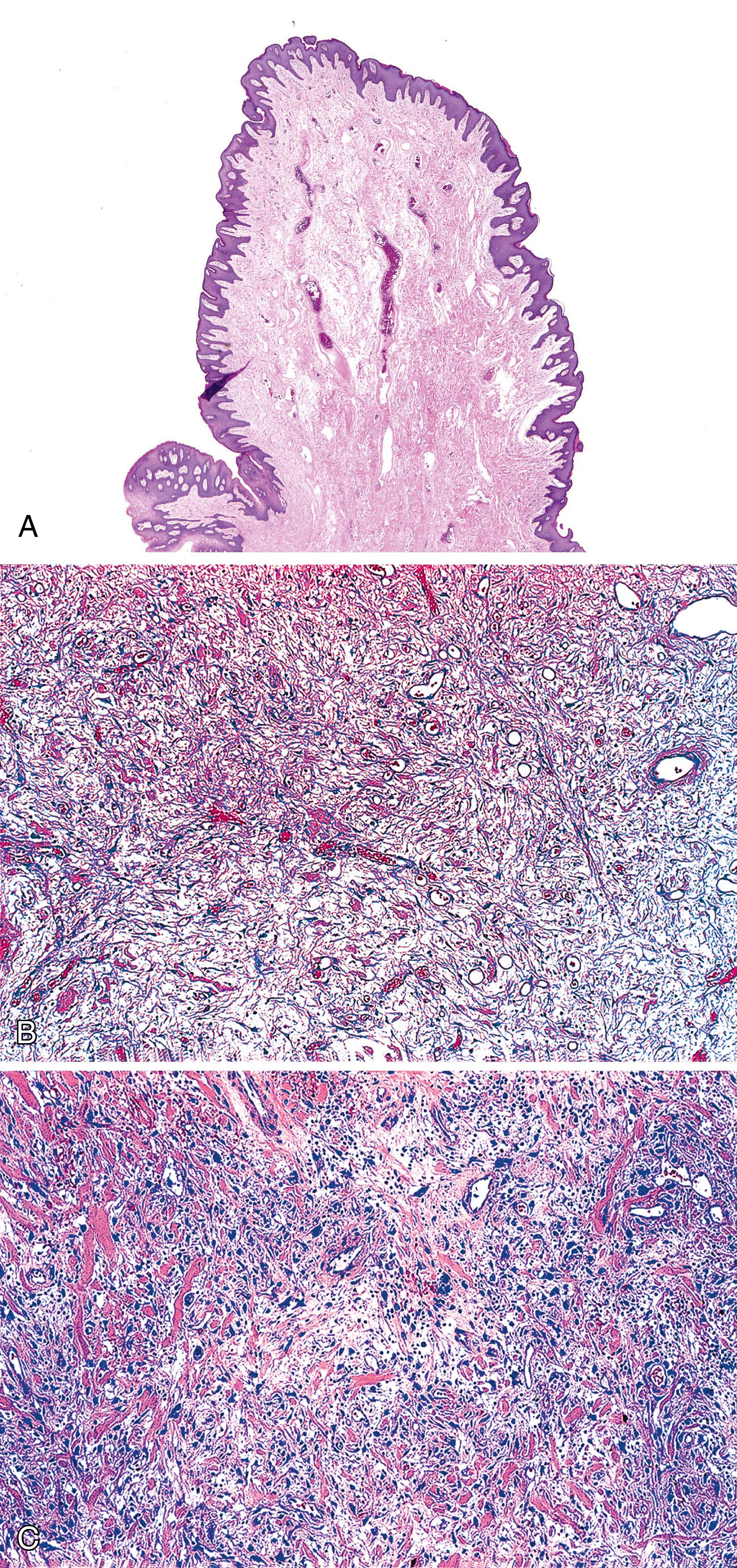
The clinical differential diagnosis of a polypoid mass in the anal canal includes hemorrhoids, infection/abscess, or other more serious disorders such as anal carcinoma or anal melanoma. Routine histological examination is usually adequate to determine the underlying pathological process. On occasion, the squamous epithelium of a fibroepithelial polyp will contain unsuspected intraepithelial neoplasia.
Hypertrophic anal papillae tend to enlarge over time and may convert from an asymptomatic to a symptomatic mass associated with pruritus, anal discharge, and discomfort. Surgical resection in symptomatic cases often results in relief of symptoms. When anal papillae accompany an underlying chronic process, treatment is often aimed at correcting the primary etiology in association with removal of the hypertrophied papillae.
Inflammatory cloacogenic polyps (ICPs) occur predominantly in middle-aged patients, although they have also been described in children. Men and women are equally affected. The most common presentation is rectal bleeding or mucous discharge. Patients who report straining at defecation are at increased risk for development of an ICP. ICPs represent one aspect of mucosal prolapse disorders of the gastrointestinal tract, which include inflammatory cap polyps, inflammatory myoglandular polyps, polypoid prolapsing folds of diverticular disease, colitis cystic profunda, and polyps associated with solitary rectal ulcer syndrome, among others. Furthermore, any type of mucosal polyp may undergo secondary prolapse changes, with resultant misplacement of mucosal elements into the submucosa or deeper layers.
The pathogenesis of ICP is believed to be similar to that of other mucosal prolapse disorders. It is likely related to chronic mucosal prolapse that occurs in long-term disorders with constipation and defecation with secondary associated ischemic, inflammatory, and reactive changes of the overlying mucosa.
These polyps are located in the anterior anal canal, may be single or multiple, and are typically sessile (see Chapter 22 for details and figures). They are variable in size, but usually range from 1 to 2 cm grossly. Histological features include fibrosis of the lamina propria, thickening of the muscularis mucosae, hyperplasia of the mucosal glands (often with a villous-like configuration) leading to a serrated contour of the epithelium, and telangiectasia of surface vasculature, either with or without fibrin thrombi ( Fig. 32.5 ). The muscularis mucosae is typically thickened and irregular, with frequent extension of fibromuscular strands into the lamina propria that results in the formation of “diamond-shaped” crypts and deposition of mucosal elastin. The presence of elastin is particularly distinctive because it is otherwise not seen in the normal rectum ( Fig. 32.5C ). The surface epithelium is characteristically composed of a mixture of colorectal, transitional, and squamous mucosa. Ischemic-type erosion of the surface epithelium is a common finding, which may contribute to regenerative or hyperplastic (serrated) epithelial changes.
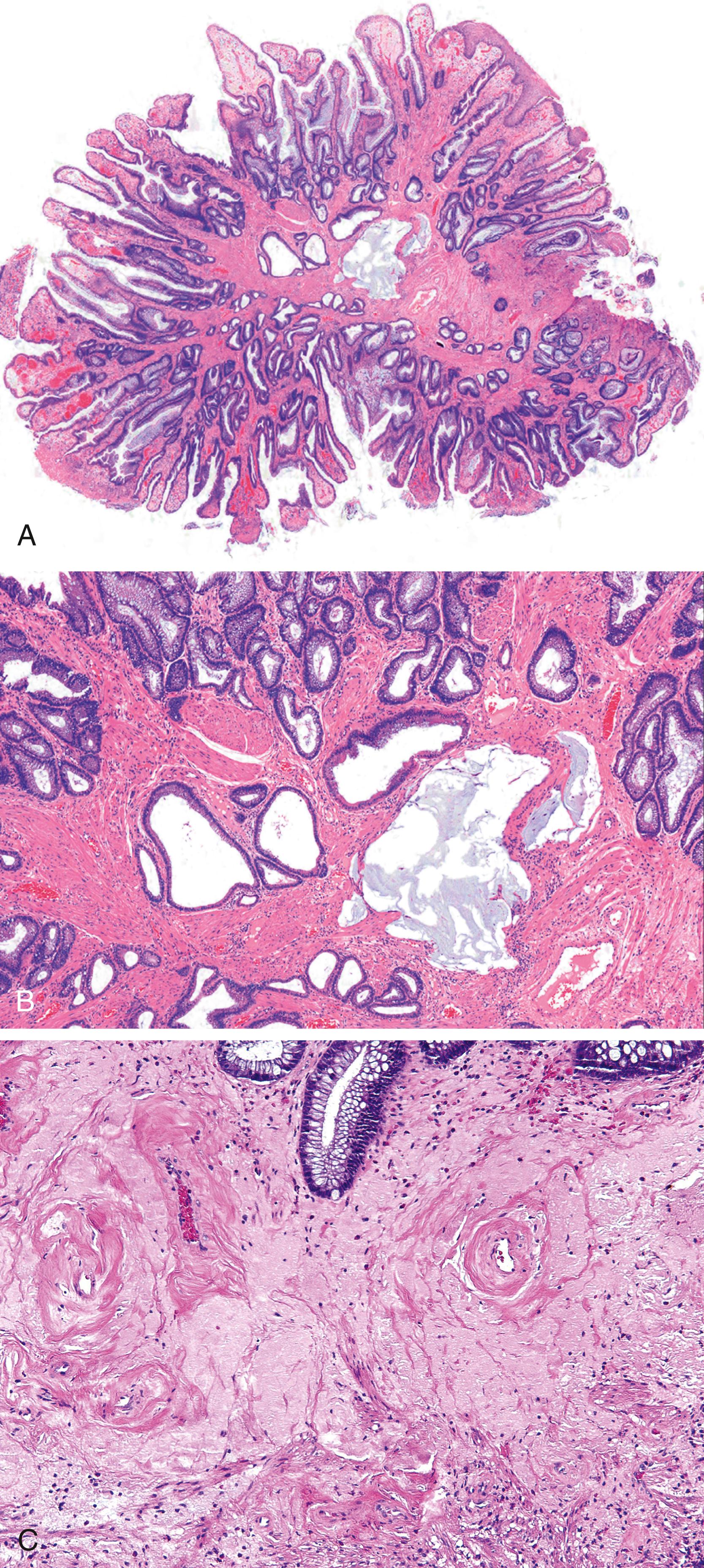
A variety of entities enter into the differential diagnosis of an ICP. Because of their location in the anal canal and low-power appearance, ICPs may resemble a tubulovillous adenoma or a traditional serrated adenoma of the distal rectum. Recognition of the regenerative (nonneoplastic) epithelial cytology and eroded surface in ICPs and an absence of cytological dysplasia helps distinguish ICP from an adenoma. In addition, ICPs typically contain both transitional and squamous epithelium. The fact that adenomas are somewhat uncommon in the age group in which ICPs are often diagnosed is also useful. In some ICPs, prominent misplacement of the reactive epithelium into the underlying fibrous stroma combined with hyperplastic musculature, also known as proctitis cystica profunda, may simulate an invasive mucinous carcinoma ( Fig. 32.6 ; see Chapter 22 for details). Although prolapse changes may also be found in invasive carcinomas, they are more prominent in ICPs, and the “misplaced” epithelium is usually accompanied by lamina propria tissue. In addition, nonneoplastic epithelium surrounding mucin pools may be found in cases of benign proctitis cystica profunda, whereas neoplastic epithelium is often found floating within mucin pools in cases of invasive mucinous adenocarcinoma. In some cases, features of prolapse may be the only finding in the mucosa overlying a malignancy; thus an underlying malignancy should always be considered when biopsy findings of a “mass lesion” reveal prolapse changes, but without neoplasm.

The presence of inflammation and a granulation tissue cap may cause diagnostic confusion with a juvenile/hamartomatous polyp or an inflammatory polyp (related to inflammatory bowel disease or sporadic). This distinction may be particularly difficult because any type colorectal polyp can undergo secondary prolapse. A low-power view of the polyp often helps one distinguish prolapse from an injury secondary to a preexisting lesion (often neoplastic). Also, it is important to note that ICPs show muscularization in the base of the polyp, whereas juvenile or inflammatory polyps do not show this feature. Furthermore, inflammatory polyps in inflammatory bowel disease usually occur in the context of chronic colitis in adjacent mucosa. Simple excision of ICPs is usually curative. Recurrences are uncommon.
Acute anal fissures are common, although the exact incidence is unknown because most patients do not present for clinical evaluation. Chronic anal fissures affect men and women equally, and they account for up to 10% of patients who are seen in colorectal clinics. Although there are no uniform criteria, most define chronicity of an anal fissure by persistence for at least 6 weeks and with visible transverse internal anal sphincter fibers on anoscopy. Other features of chronicity include an indurated edge and the presence of a hypertrophic anal papilla ( Fig. 32.7A ). When a fissure becomes large, deep, and chronic, it is often referred to as an anal ulcer . Patients typically present with intense pain, particularly after defecation.
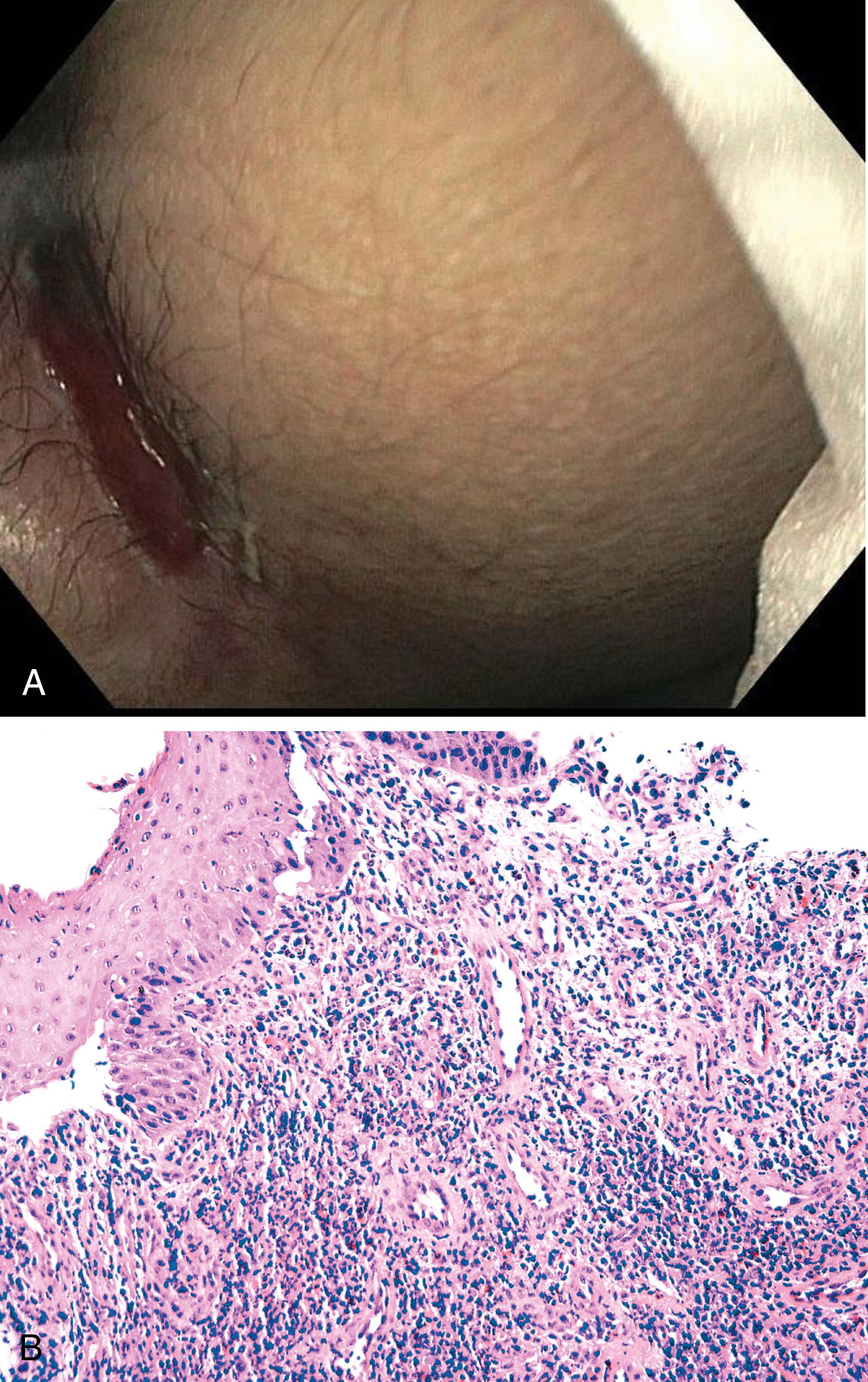
The term anal tear refers to an acute linear tear in the mucosa of the anal canal. Although most anal tears heal spontaneously, the development of an anal fissure is associated with spasm of the internal anal sphincter and a reduction in mucosal blood flow that leads to delayed or failed healing of the initial mucosal injury. Chronic anal fissures are further propagated by an increased resting internal anal sphincter tone. In patients with a normal sphincter tone, other factors have been linked to the development of an anal fissure, such as HIV infection, anal receptive intercourse, sexual abuse, Crohn’s disease, and previous obstetric operations or anorectal malformation repair.
Anal fissures typically extend from the dentate line to the anal verge in the posterior midline of the anal canal overlying the lower portion of the internal sphincter. Histologically, anal fissures/ulcers are characterized by nonspecific acute and chronic inflammation, granulation tissue, and reactive changes of the squamous epithelium at the edges of the fissure ( Fig 32.7B ). Chronic fissures are also frequently associated with hypertrophy of the anal papillae at the proximal end of the lesion, Histologically, hypertrophic anal papillae are similar to other types of benign fibroepithelial polyps.
In cases in which a fissure is located in an unusual location or fails to heal after treatment, inflammatory bowel disease (most often Crohn’s disease), neoplasm, or infectious processes should be considered.
Most acute fissures are superficial and heal quickly. Healing may be facilitated by increased dietary fiber and water, stool softeners, and warm sitz baths. For nonhealing acute anal fissures or chronic anal fissures, medical management is recommended for first-line treatment with the aim of reducing internal anal sphincter resting pressure. , , Current medical treatments include use of topical calcium channel blockers (nifedipine or diltiazem) to reduce anal sphincter tone; nitric oxide donors, such as topical glyceryl trinitrate (GTN), to increase anodermal blood flow; and botulinum toxin to reduce resting internal anal sphincter tone. All three of these methods have been associated with similar healing rates, but topical calcium channel blockers are reported to have the benefits of fewer side effects than topical GTN and lower cost than botulinum toxin. If these methods fail or if the fissures recur, surgical management may be indicated using approaches such as anal dilation, internal sphincterotomy, or fissurectomy. Surgical management permits healing of chronic fissures in up to 100% of patients with low rates of recurrence. Patients with recurrent anal fissure after surgical management should be evaluated for alternative causes, such as Crohn’s disease, sexually transmitted disease, sexual abuse, or HIV infection.
Most anal fistulas or abscesses are idiopathic, although they may occur in patients with Crohn’s disease or carcinoma in this region. Anorectal abscesses may also be found in patients with hidradenitis suppurativa. In hidradenitis patients, wound healing is often complicated by coexistent obesity and diabetes.
Anal abscesses and fistulas represent different stages of anorectal suppurative disease. The majority of suppurative processes in this location are believed to arise after infection of an anal duct/gland, which provides a pathway from the anal canal to perineal soft tissues. , In the acute phase, an abscess may form, whereas a fistula represents the chronic phase of infection, occurring in 20% to 50% of patients with an anal abscess. , , There are no reliable ways to predict which patients will progress to a fistula. Fistulas are usually classified according to their relationship to the external anal sphincter (i.e., intersphincteric, transsphincteric, suprasphincteric, or extrasphincteric; Figure 32.8 ).
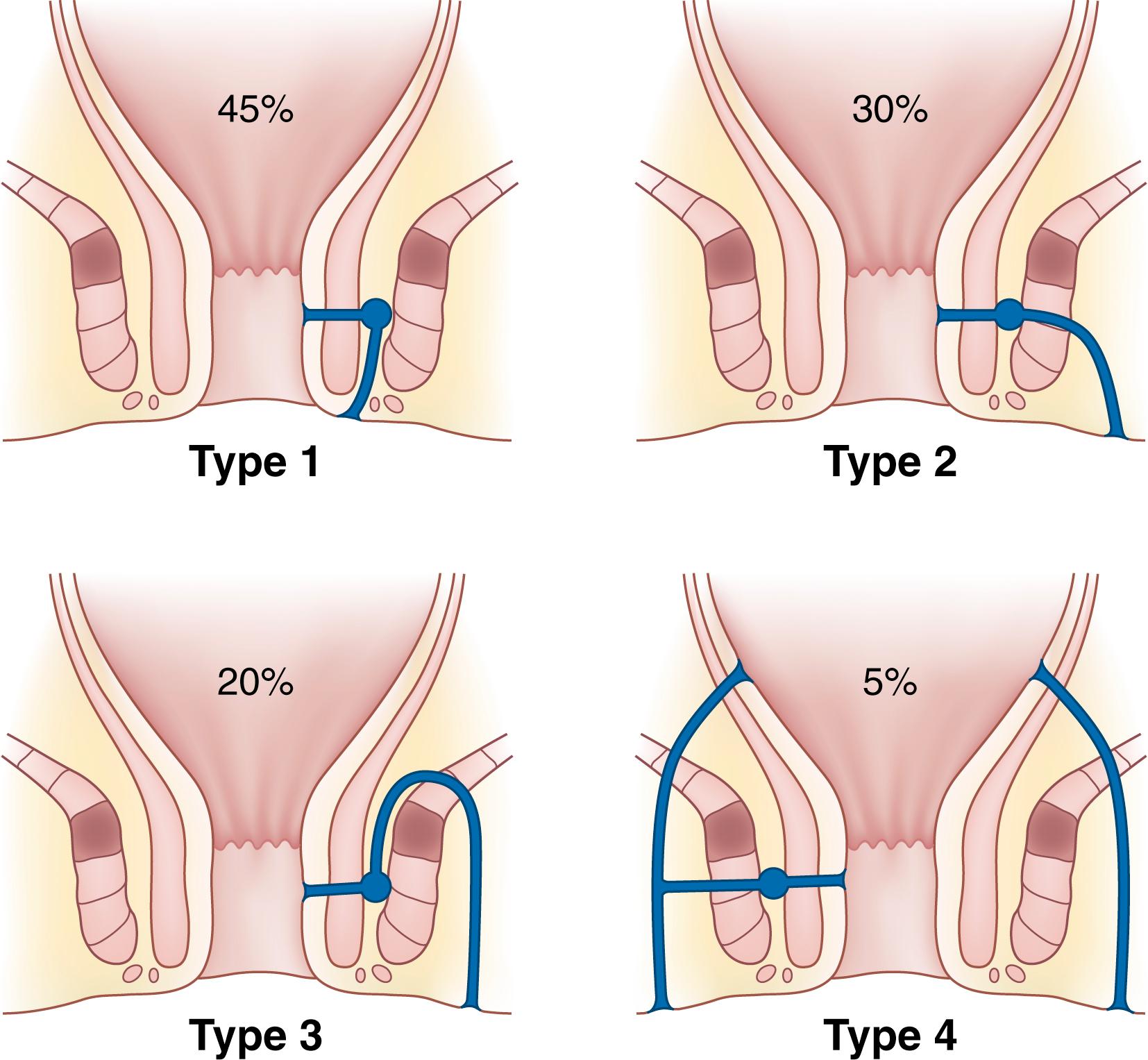
Histological specimens obtained from fistulas show nonspecific acute and chronic inflammation, fibrosis, and granulation tissue. Foreign-body giant cell reaction to fecal matter may also be seen in specimens from fistula tracts of the anus and should not be confused with the well-formed, sarcoid-like granulomatous reaction typical of Crohn’s disease. In patients with hidradenitis suppurativa, the histological findings in the anal canal are identical to those found in other affected locations.
Any cause of infection or fistula formation should be considered in the differential diagnosis of an anal abscess or fistula. A thorough histological examination, including multiple sections, should be conducted to rule out an underlying neoplasm, and special stains for acid-fast bacilli, fungal forms, or other infectious organisms should be performed, particularly if granulomatous inflammation is found. A careful review of the patient’s clinical history, including the presence of inflammatory bowel disease, should be obtained.
Antibiotics are often ineffective because of poor penetration into inflamed areas. Incision and drainage remains the primary method of treatment modality for anal abscesses, but recurrences are relatively common. Wide surgical excision is curative in most cases of idiopathic anal abscess or fistula.
Individuals who engage in unprotected anal intercourse are at greatest risk for acquiring anorectal infections. Thus anorectal infections are most common among men who have sex with men (MSM). The symptoms of an anorectal infection may vary depending on the specific infection or pathological process, but they are often indistinguishable from those of inflammatory bowel disease. The most common symptom is a frequent or continuous urge to have a bowel movement. Other symptoms include anorectal pain or discomfort, anal discharge (which may be purulent, mucoid, or blood-stained), tenesmus, urgency of defecation, rectal bleeding, and constipation. Systemic symptoms, such as fever, may also occur. However, many patients are asymptomatic.
Infections of the anal canal are most often caused by sexually transmitted pathogens. The most common agent identified is Neisseria gonorrhoeae (gonorrhea), found in 30% of patients, followed by Chlamydia trachomatis (19%), herpes simplex virus (HSV) type 2 (16%), and Treponema pallidum (syphilis; 2%). HSV type 1 accounts for 13% of anorectal herpes infections and likely represents ano-oral transmission. The incidence of anorectal disease caused by C. trachomatis, the causative agent of lymphogranuloma venereum (LGV), is increasing. , More than one infection may be present in a single individual.
Different pathogens typically infect different types of mucosa. HSV and T. pallidum infect the stratified squamous epithelium of the perianal area and anal verge, although syphilitic proctitis also occurs. , As in other sites, HSV infections are associated with small vesicles that ulcerate and are seen histologically as mucosal ulcerations with associated acute and chronic inflammation and granulation tissue. Virally infected multinucleated cells with smudged chromatin may be seen in routine hematoxylin and eosin (H&E) sections, although immunohistochemical stains are of great value in confirming the presence of virally infected cells ( Fig. 32.9A,B ). In contrast, syphilis is commonly associated with a chronic inflammatory infiltrate rich in plasma cells and may also show associated granulomatous inflammation ( Fig. 32.9C–E ). Dark-field microscopy of exudates from anorectal ulcers may be inaccurate as a result of contamination from commensal spirochetes found in the normal flora of the colorectum; however, T. pallidum immunohistochemical stains have become a useful tool for surgical pathologists ( Fig. 32.9E ). Demonstration of antibodies in the serum is the gold standard of syphilis diagnosis. Serological tests consist of two main types of nonspecific cardiolipin antigen test: the Venereal Disease Research Laboratory slide test and the rapid plasma reagin test. These tests can be used to diagnose primary and secondary syphilis and to monitor treatment response. The specific treponemal antigen tests (i.e., enzyme immunoassay, T. pallidum hemagglutination assay, T. pallidum particle agglutination assay, fluorescent treponemal antibody absorption test) stay positive even after treatment and can detect latent syphilis in untreated adults. Infections occurring between the anal verge and the dentate line tend to be extremely painful because of the abundance of sensory nerve endings in this area. Chlamydial infections and gonorrhea target the columnar epithelium of the rectum. One may see evidence of cryptitis, crypt abscesses, and reactive epithelial changes in affected individuals ( Fig. 32.9F ), but the degree of activity and chronic injury is characteristically less than untreated inflammatory bowel disease. , Granulomas are not uncommon. Polymerase chain reaction amplification for C. trachomatis DNA is the standard diagnostic test for anorectal chlamydial infection. The rectum itself has few sensory nerve endings, so infections that spare the anus may be painless.
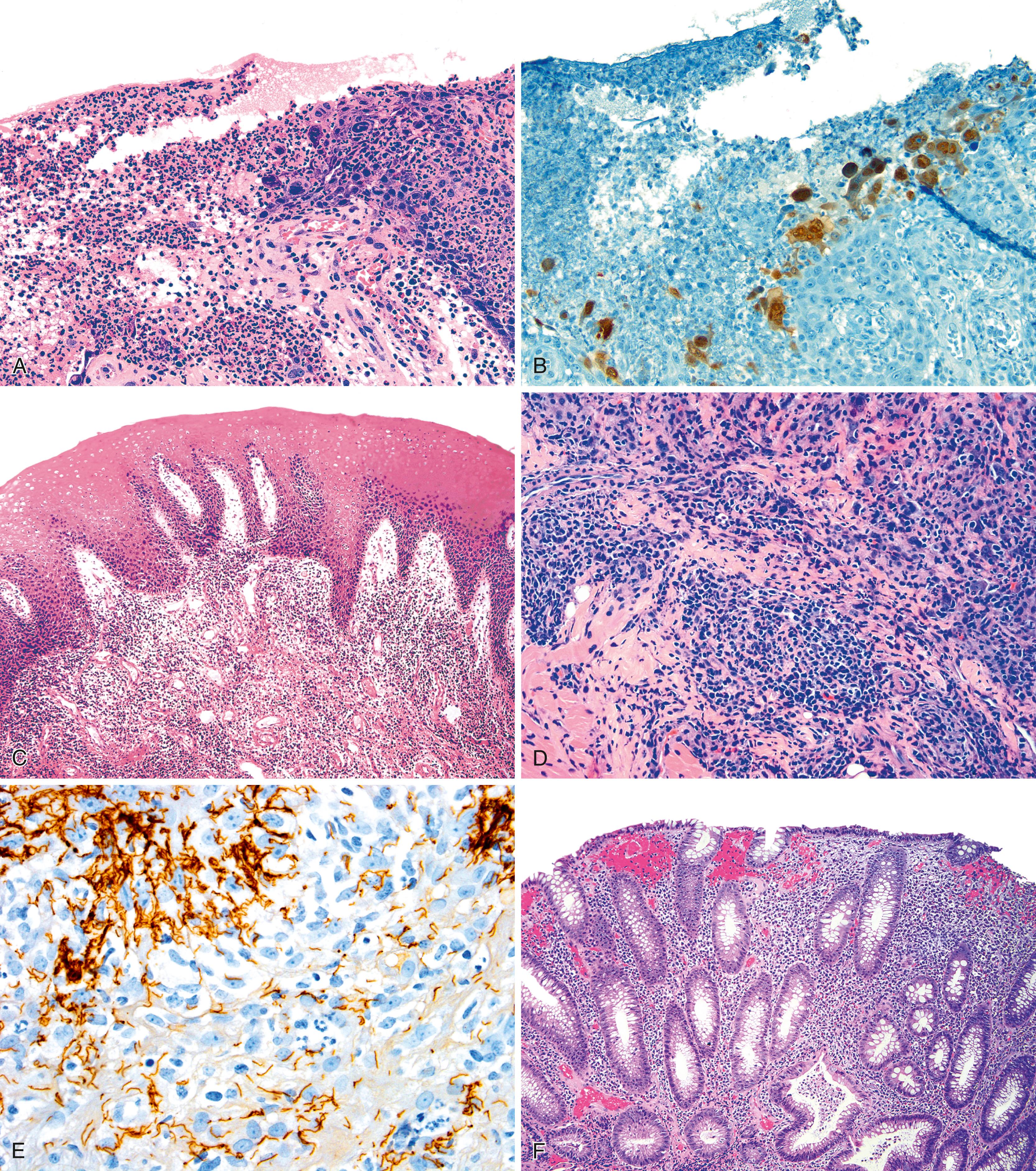
Solitary anal ulcers, as in HSV infection, may be misdiagnosed clinically as a chronic anal fissure. Granulomatous inflammation can lead to the formation of a rectal mass in both primary and secondary syphilis, and this must be differentiated from other causes of a rectal mass, such as a neoplasm. Condylomata lata occurring in the perianal region in syphilis patients appear as moist, wartlike lesions and may be confused for human papillomavirus (HPV) infection. The pain, tenesmus, bloody discharge, and constipation of untreated LGV may mimic Crohn’s disease. In the tertiary stage, anorectal fistulas and strictures may also occur in LGV.
Become a Clinical Tree membership for Full access and enjoy Unlimited articles
If you are a member. Log in here